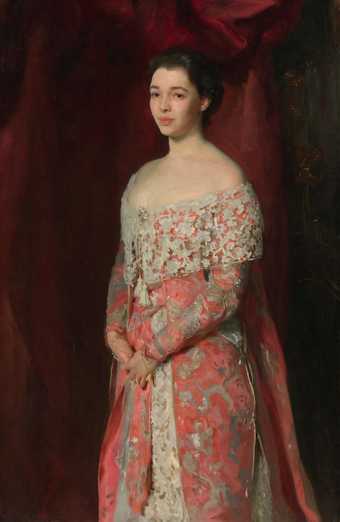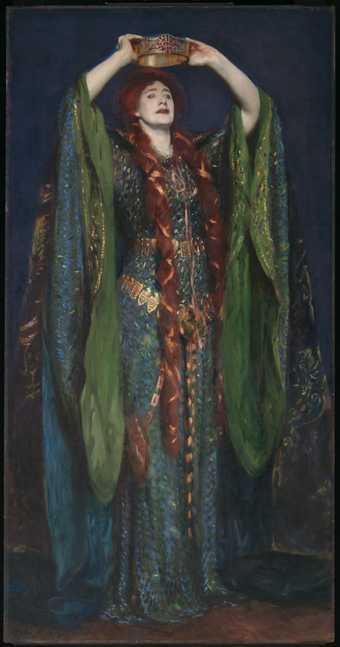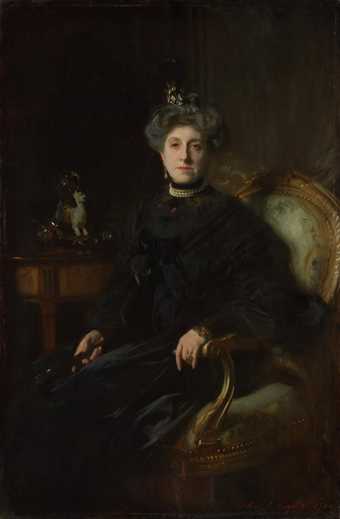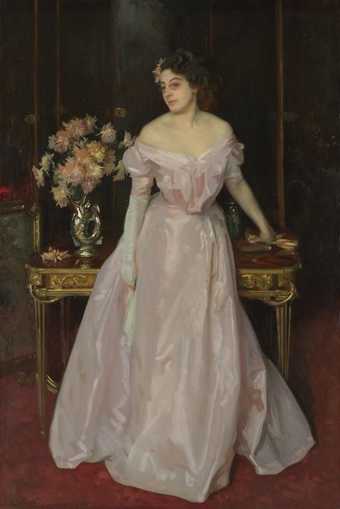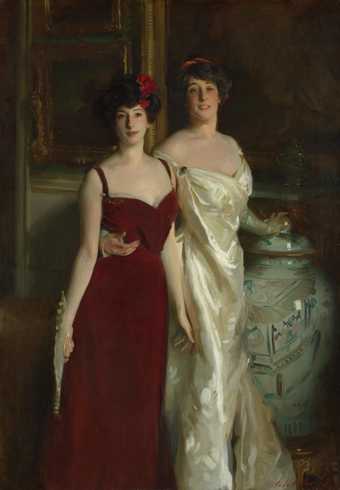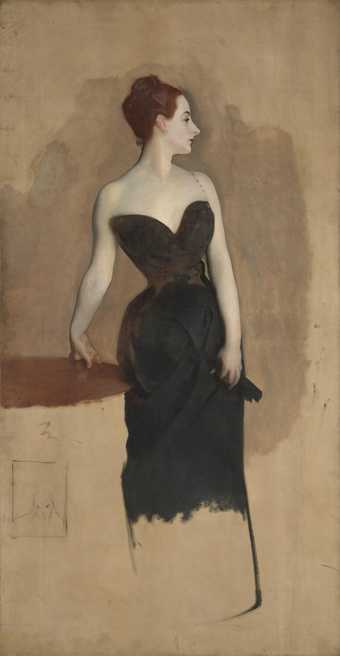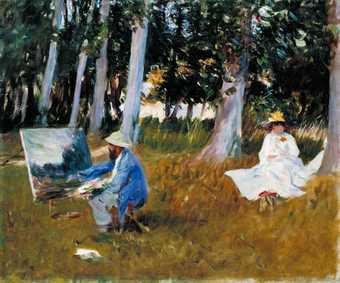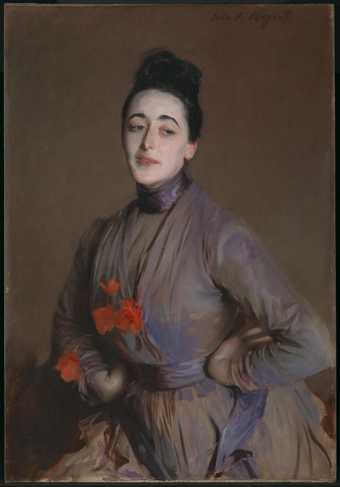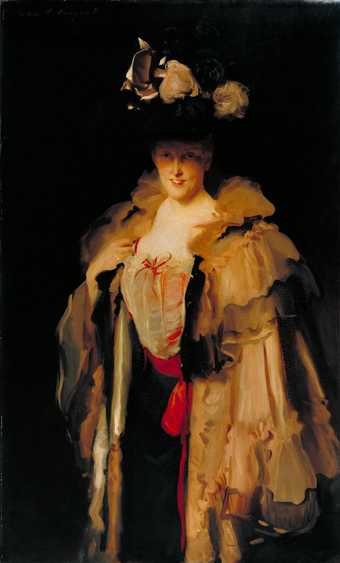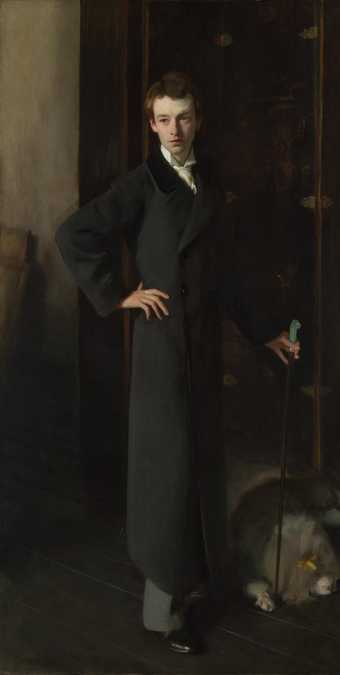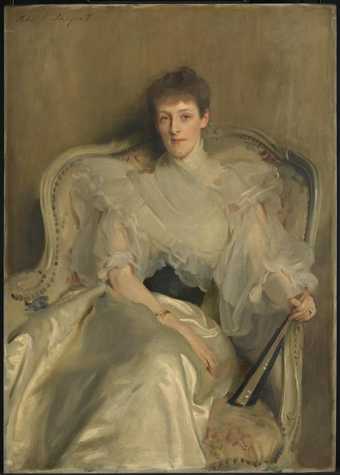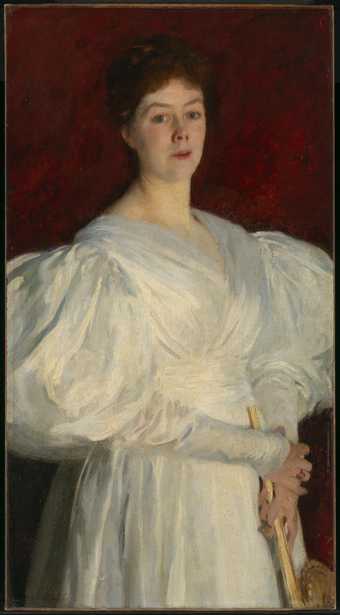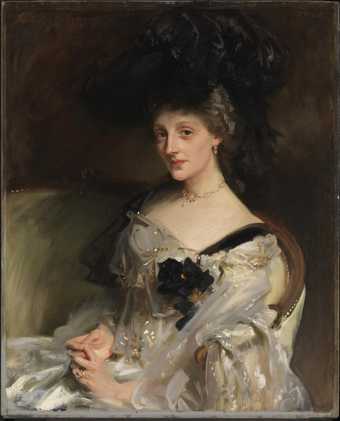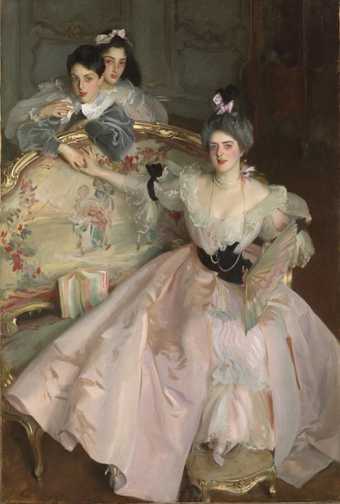
Not on display
- Artist
- John Singer Sargent 1856–1925
- Medium
- Oil paint on canvas
- Dimensions
- Support: 1578 × 803 mm
frame: 1801 × 1031 × 105 mm - Collection
- Tate
- Acquisition
- Bequeathed by Miss P.J.M. Harrison 2000
- Reference
- T07693
Summary
Sargent moved from Paris to London in the summer of 1885. Finding it difficult to attract patrons, he turned to his friends and family for portrait commissions. He may have been introduced to the cousins Robert and Peter Harrison by Alma Strettell. The future wife of Peter Harrison, Strettel was a close friend of Sargent and, in 1877, he had illustrated her book, Spanish and Italian Folk Songs. Mrs Robert Harrison, née Helen Smith (c.1858-1936), was the daughter of a wealthy Tyneside businessman and politician. At the age of nineteen she married the stockbroker and musical connoisseur, Robert Harrison of Shiplake Court, Henley. The Harrisons, like many of Sargent's patrons, formed part of the high society of late Victorian Britain. However they had unconventional tastes. For example in 1886, the year of this portrait, Robert Harrison also bought one of Whistler's night time views of London, Nocturne in Blue and Gold: Old Battersea Bridge (Tate N01959). At this time memories of the notorious libel case between Ruskin and Whistler which had taken place in 1878 were still alive in the public imagination (Ormond, p.144).
The Portrait of Mrs Robert Harrison was begun in 1886, shortly after Sargent had returned from a summer in France. Ormond has suggested that this painting is a bridge between the two dominant styles of late nineteenth-century French painting, Realism and Impressionism. The details of the head and hands are precise, yet the colouring of the portrait shows a move away from the old masterly emphasis of Sargent's style, inspired by his friendship with Monet and the work of the Impressionist artists he had seen in France.
The change in Sargent's style contributed eventually to the creation of a market for his portraits among members of London society, but approval came slowly. Following the exhibition of this portrait at the Royal Academy in 1886, The Athenaeum reported that 'An exercise in white, red and grey; is, so far as this goes, excellent, although it is decidedly unpleasant as a household companion, and, for the owner's sake, we hope unjust to the lady' (Ormond, p.144). Her unusual dress was also commented upon. The columnist for the Evesham Journal and Four Shires Advertiser exclaimed that she had never seen Mrs Harrison 'wearing such red wing-like appendages to her costume, which look as though about to expand and convey her to the regions of Mephistopheles' (Ormond, p.144). Two years after this portrait was completed, Sargent painted the Harrison's eldest son, Cecil (Southampton City Art Gallery). In contrast to the portrait of Mrs Robert Harrison, Sargent's portrait of the ten year old Cecil was praised by the Art Journal for 'the brilliance and purity of its flesh colour and for the truth with which the boy's navy-blue costume has been represented.' (Ormond, p.183)
Further reading:
William Howe Downes, John S. Sargent: His Life and Work, Boston 1925, p.143
Richard Ormond, Elaine Kilmurray, John Singer Sargent : Complete Paintings Volume 1: The Early Portraits, New Haven and London 1998, pp.18 and 144-5, reproduced in colour p.145
Heather Birchall
December 2001
Does this text contain inaccurate information or language that you feel we should improve or change? We would like to hear from you.
Display caption
Helen Smith was the daughter of a wealthy Tyneside businessman and politician. She married the stockbroker and music connoisseur Robert Harrison, of Shiplake Court in Henley-on-Thames. Like many of Sargent’s patrons the Harrisons were part of late Victorian high society. But they had unconventional taste, as Mrs Harrison’s dress shows. When the portrait was exhibited at the 1886 Royal Academy one commentator exclaimed that she had never seen Mrs Harrison ‘wearing such red wing-like appendages to her costume, which look as though about to expand and convey her to the regions of Mephistopheles’.
Gallery label, November 2016
Does this text contain inaccurate information or language that you feel we should improve or change? We would like to hear from you.
Technique and condition
The support is a single piece of fine, plain-woven, linen canvas, attached to a five bar, wooden stretcher. This stretcher, though original, looks like a composite; the two uprights are wider than the three horizontal bars, a feature which may result from the moment during painting when the artist decided to reduce the width of the image by about six inches/ 15 cms. (The flaps of original canvas on the back of the uprights have a row of tack-holes and traces of paint matching the background and costume). Sometime recently, before acquisition by the Tate, the support was lined with a coarsely woven, linen canvas attached to the original with a waxy-looking adhesive, perhaps a starch 'compo' paste impregnated with wax as a moisture barrier.
The smooth, off-white priming has the appearance of a commercial preparation and is present on all canvas margins. Its adhesion to the support is sound, though sharp cracking in the thick paint on the white sash suggests there may have been some tendency to flake before lining.
The painting itself in very good condition, the lining having caused no damage to the crisp impasto in the sash and the removal of earlier varnish having been skillful. Brushwork is lively in all areas. Time has left its mark in two areas: the face, particularly the pink cheek, where repeated reworking by the artist has caused the paint to become wrinkled and slightly shrunken; and secondly the leading edge of the red garment, extended over onto the dress during painting and now cracked as a result. Neither feature is especially noticeable in normal viewing conditions. After reducing the width of the stretcher the artist appears to have repainted the lower left quadrant of the painting, making the figure more column-like. He then applied a light-toned scumble over the whole background, stopping just short of the turnover edge.
The varnish is a recent one, probably contemporary with the lining. It looks like a synthetic resin and is clear, evenly applied and has a medium gloss.
The frame is probably the original, though it has been regilded at some point. It is a carved moulding with 'compo' decorations and it is in the French neo-classical style.
Rica Jones
February 2001
Explore
- objects(23,571)
-
- clothing and personal items(5,879)
- actions: postures and motions(9,111)
-
- standing(3,106)
- woman(9,110)
- Harrison, Helen(1)
- Smith, Helen(1)
- individuals: female(1,698)
You might like
-
John Singer Sargent Portrait of Mrs Leopold Hirsch
1902 -
John Singer Sargent Ellen Terry as Lady Macbeth
1889 -
John Singer Sargent Mrs Wertheimer
1904 -
John Singer Sargent Hylda, Daughter of Asher and Mrs Wertheimer
1901 -
John Singer Sargent Ena and Betty, Daughters of Asher and Mrs Wertheimer
1901 -
John Singer Sargent Study of Mme Gautreau
c.1884 -
John Singer Sargent Claude Monet Painting by the Edge of a Wood
?1885 -
John Singer Sargent Miss Priestley
c.1889 -
John Singer Sargent Mrs Charles Hunter
1898 -
John Singer Sargent Vernon Lee
1881 -
John Singer Sargent W. Graham Robertson
1894 -
John Singer Sargent Jean, Wife of Colonel Ian Hamilton
1896 -
John Singer Sargent Mrs Frederick Barnard
1885 -
John Singer Sargent Mrs Philip Leslie Agnew
1902 -
John Singer Sargent Mrs Carl Meyer and her Children
1896

